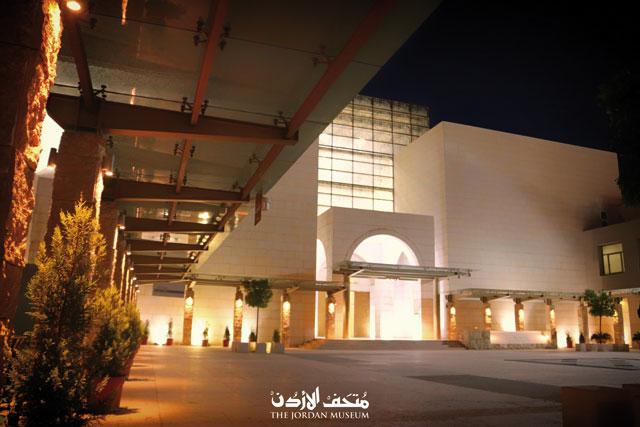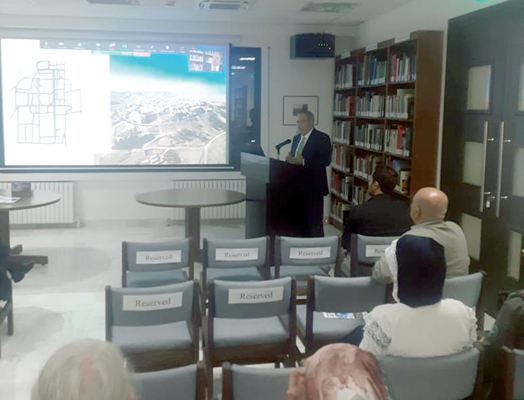You are here
A mirror into the past, Jordan Museum strives to educate on rich heritage
By Dana Al Emam - Feb 11,2017 - Last updated at Feb 11,2017

Jordan Museum’s 10,000-square-metre building, located in Amman’s Ras Al Ain area, consists of showrooms that exhibit nearly 1,000 pieces (Photo courtesy of Jordan Museum)
AMMAN — Nestled in the heart of the capital city is a museum that chronicles a million years of historical events, inventions and ways of life in civilisations, which existed in Jordan and the region
Since the 1960s, there has been a national dream of establishing the Jordan Museum, with the aim of documenting, conserving and presenting Jordan’s archaeological and cultural heritage, said Ihab Amarin, the museum’s director general.
The dream was partially realised in 2013 with the opening of the museum’s first phase, which chronologically documents the Palaeolithic period (Old Stone Age) up to the end of the Classical periods, just before the Islamic era, he told The Jordan Times in a recent interview.
In addition to its role in collecting and preserving archaeological artefacts, the museum seeks to educate citizens, particularly school and university students, to encourage them to understand, respect and preserve their national identity, evoking a sense of belonging among them.
The museum seeks to engage visitors through a number of interactive stations, such as “please touch” signs next to replicas of artefacts, where visitors can touch stone engravings.
“Around 45 per cent of some 24,000 visitors in 2016 were school students,” Amarin said, highlighting the museum as a component that enriches the touristic experience of the Kingdom’s guests as well.
Among several valuable artefacts on display in the museum are the famous 9,700-year-old Ain Ghazal statues, which are the most ancient statues in the world, the nearly 5,000-year-old Tulaylat Al Ghassul Wall Painting, the Tal Siran Bottle from which the names of Ammonite kings came from and the unique Dead Sea Copper Scroll.
Museum Curator Yosha Alamri said the museum was designed according to international standards that entail specific heating and lighting requirements to preserve artefacts.
Commenting on the archaeological value of the exhibited artefacts, he said the Ain Ghazal statues, for example, were originally made of reed, which is the result of a chemical reaction of calcium carbonate under temperatures exceeding 900ºC. This indicates the advanced skills in chemistry in ancient times.
For decorating the statues, groups of inhabitants had travelled for days to Ajloun and the Dead Sea to collect materials.
“Travelling for these durations would necessitate somebody or some authority to look after families of those tasked to take the trips, so there must have been a sort of social order and an organised society that catered for the needs of those families,” Alamri told The Jordan Times.
Exhibited artefacts also show the development of lifestyle and tools in a manner that helped inhabitants adapt to weather conditions, he noted.
For his part, Amarin said the Copper Age, which witnessed the extraction and use of copper, documents a sort of “an industrial revolution”, a development he described as another milestone in human history.
The museum also showcases complex irrigation and water harvesting systems in Petra and Jawa, located in the eastern desert.
In addition, the archaeological hub depicts how the Romans managed to erect Jerash columns and how they employed hydraulic power in cutting stones.
The 10,000-square-metre building consists of showrooms that exhibit nearly 1,000 pieces, while around 2,500 others are kept in storage.
The second phase of the museum is to document the Early Islamic period up to present time.
While the museum’s administration has started working on the second phase, it is expected to open in two-to-three years if the needed funds are secured, said Amarin, who added that insufficient funds affect the ability to attract and retain human resources.
“A museum is a never-ending project, as there are always new archaeological discoveries to incorporate,” he said, adding that partnerships with several private and public institutions have helped the museum reach the place it is in today.
This support is also helping the museum implement its expansion plans.
As part of the World Science Forum 2017 and in light of the selection of Amman as the capital of Islamic culture for 2017, the museum is scheduled to host a special exhibition in March on renowned Arab scientist Ibn Al Haytham to shed light on his significant contributions.
In addition, the museum will host the 1001 Inventions Exhibition to showcase contributions of Arab scientists and innovators. This event will take place in August or September.
“The main aim of the Jordan Museum is to present the real image of enlightenment and innovation in this country and its people as opposed to some distorted views,” Amarin concluded.
Related Articles
AMMAN — Visitors of The Jordan Museum are given the chance to travel through time and history, as displayed artefacts tell stories of a land
AMMAN — A lifelong passion for history and archaeology led Ihab Amarin, director of The Jordan Museum, to pursue the field as his profession
AMMAN — The Jordan Museum is scheduled to host a month-long exhibition showcasing the achievements of Arab scientist Ibn Al Haytham next mon
















